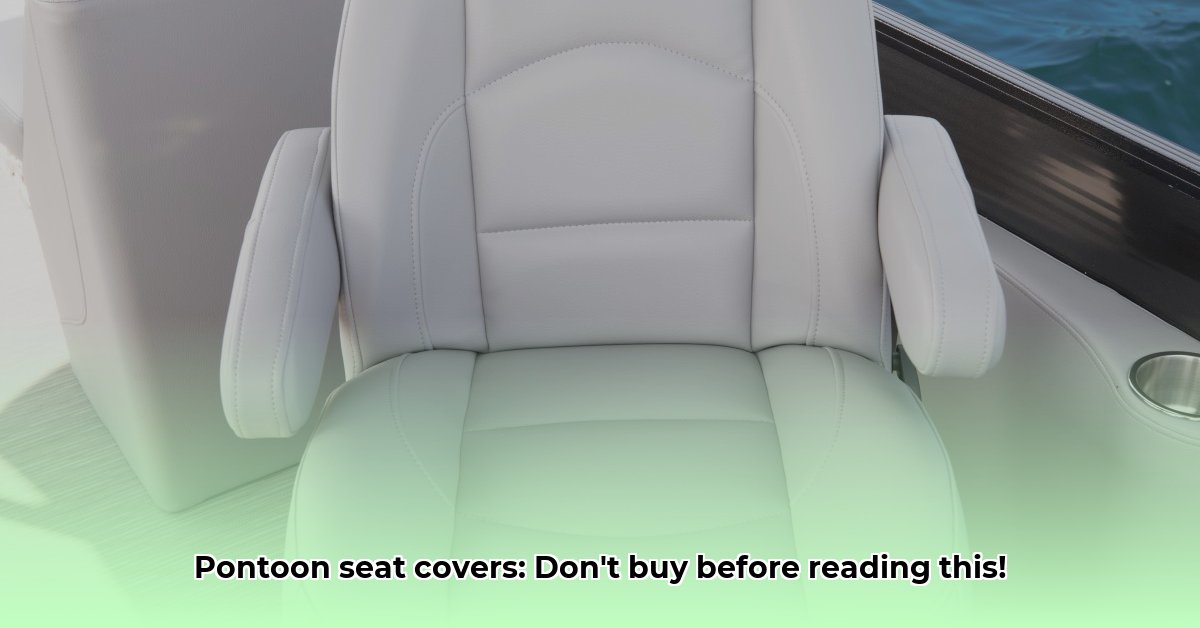Protecting your pontoon boat’s seats is crucial for maintaining its appearance and value. This comprehensive guide covers everything from choosing the right materials and fit to caring for your covers, ensuring your pontoon stays in top shape for years to come.
Choosing the Right Material
Selecting the right material is like picking the perfect outfit – it needs to be comfortable, durable, and fit for purpose. Let’s explore the most popular options:
Vinyl: The Workhorse
Marine-grade vinyl is the heavy-duty champion, offering exceptional durability and waterproofing. It’s easy to clean and resists mildew, making it ideal for harsh conditions. However, vinyl can stiffen in cold weather and may trap heat on sunny days. The cost is typically higher, but its robust nature might justify the investment for some boat owners.
Polyester: The Breathable Option
Polyester blends provide a lighter, more breathable alternative. They offer decent water repellency and UV protection, making them a good choice for regular use. While not as rugged as vinyl, polyester is more comfortable on hot days and usually more affordable.
Solution-Dyed Acrylic: The Long-Lasting Choice
This premium option offers superior fade resistance, as the color is woven into the fibers. It’s incredibly durable, breathable, and resists mildew, making it a top contender for long-term protection. However, the higher price tag may be a deciding factor for some.
Canvas: The Classic Choice
Canvas offers a traditional look and excellent breathability. While durable, it requires more maintenance and is less water-resistant than vinyl or acrylic. It’s a good choice for boaters who prioritize breathability and a classic aesthetic.
Material Comparison Table
| Material | Durability | UV Resistance | Water Resistance | Breathability | Cost |
|---|---|---|---|---|---|
| Marine-Grade Vinyl | Excellent | Good | Excellent | Low | High |
| Polyester Blend | Good | Excellent | Good | High | Moderate |
| Solution-Dyed Acrylic | Excellent | Excellent | Excellent | Excellent | High |
| Canvas | Good | Moderate | Moderate | Excellent | Moderate |
Finding the Perfect Fit: Cover Types
Just like clothing, covers come in different styles:
Custom-Fit Covers: The Bespoke Suit
These covers are made to your boat’s exact measurements, offering the ultimate protection and a polished look. They are the most expensive option but provide the best fit and defense against the elements.
Semi-Custom Covers: The Off-the-Rack Option
Semi-custom covers offer a balance of fit and affordability. They are designed to fit a range of seat sizes within specific boat models, providing a good compromise between cost and protection.
Universal Covers: The One-Size-Fits-All
These are the most budget-friendly but may not provide the snuggest fit. They are suitable for occasional use or tight budgets but offer less protection than custom or semi-custom options.
Essential Features to Consider
Beyond material and fit, consider these features:
UV Resistance: Protecting Against the Sun’s Rays
Look for covers with UV protection to prevent fading and damage caused by prolonged sun exposure.
Breathability: Preventing Mold and Mildew
Breathable covers allow air to circulate, minimizing moisture buildup and reducing the risk of mold and mildew.
Tie-Down Options: Keeping Covers Secure
Secure tie-down options, such as straps or buckles, are essential for keeping covers in place during windy conditions. Reinforcements, usually in the form of double or triple stitching, are important for high stress points.
Measuring Your Seats: A Step-by-Step Guide
Accurate measurements are key for a snug fit, especially for custom or semi-custom covers.
- Gather Your Tools: Tape measure, pen, and paper.
- Measure the Width: Measure the widest part of the seat from side to side.
- Measure the Depth: Measure from the front edge to the back.
- Measure the Height (for backrests): Measure from the top to the bottom.
- Record and Label: Clearly label each measurement for accurate ordering. Take photos particularly if the shape is uncommon.
Top-Rated Pontoon Boat Seat Cover Brands
While brand recommendations can change over time as new products emerge and testing evolves, some consistently well-regarded manufacturers include Carver, Shoretex, and Great Lakes Boat Top. Be sure to do your research and read recent reviews to stay abreast of current user satisfaction and product innovation.
Care and Maintenance: Extending the Life of Your Covers
Proper care maximizes the lifespan of your covers:
Regular Cleaning
Clean covers regularly with mild soap and water to remove dirt and grime. Avoid harsh chemicals that could damage the fabric.
Proper Storage
Store covers in a clean, dry place away from direct sunlight during the off-season to prevent mildew and damage. Consider using breathable storage bags to manage air circulation.
Frequently Asked Questions (FAQ)
-
How often should I clean my pontoon boat seat covers? Cleaning frequency depends on usage and environmental factors. A good rule of thumb is to clean them monthly during periods of heavy use and at least twice a year during the off-season.
-
Can I use bleach on my boat seat covers? Check the manufacturer’s instructions. While some materials can tolerate diluted bleach solutions for mildew removal, it’s generally best to avoid bleach as it can weaken and fade fabrics over time.
-
What’s the best way to store my covers during the winter? Store covers in a clean, dry, and well-ventilated area, away from direct sunlight and extreme temperatures. Consider breathable storage bags.
-
How do I repair a small tear in my seat cover? For minor tears, marine-grade repair patches or vinyl adhesive can be effective. For larger tears, professional repair may be necessary.
Conclusion
Choosing the right pontoon boat seat covers is an investment that protects your boat and enhances your enjoyment on the water. By considering the factors discussed in this guide, you can make an informed decision and keep your pontoon looking its best for years to come.
- Dora the Explorer Wipe-Off Fun: Safe & Mess-Free Activities for Little Explorers - April 18, 2025
- Does Lemongrass Repel Mosquitoes? Fact vs. Fiction + How to Use It - April 18, 2025
- Do Woodchucks Climb Trees?Fact vs. Fiction - April 18, 2025










